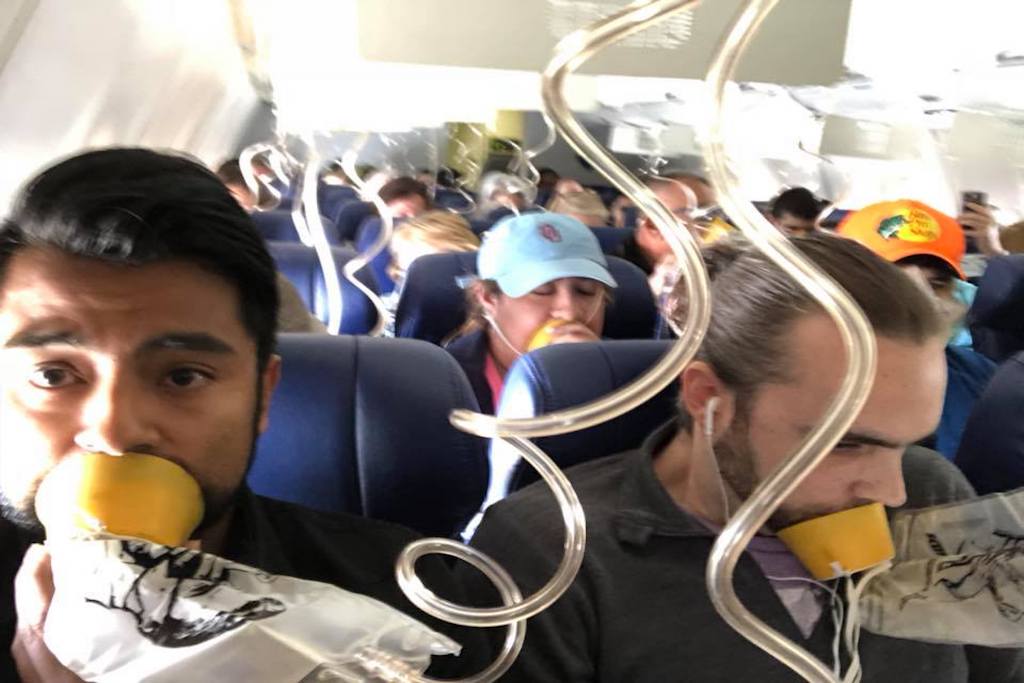Skift Take
The Southwest accident shows how bold passengers have become in using social media. For now, the FAA isn’t taking steps to curb their activities.
Airline passengers have always loved taking photos on airplanes, whether it’s the food on their tray tables, the view outside the window or celebrating with champagne flutes.
But last week brought a new watershed in the use of electronic devices on board planes, making the world aware of an airplane in crisis in real time.
Marty Martinez, a passenger on Southwest Flight 1830, broadcast from the aircraft via Facebook Live soon after the airplane’s engine blew out, forcing an emergency landing in Philadelphia. A passenger died during the incident.
Martinez paid $8 to purchase internet access, thinking he would capture his “final moments on earth,” he later told CNN.
Starting while the plane was still in the air, he uploaded two videos and a series of photos to his Facebook page, showing himself with an oxygen mask, as well as damage to the aircraft.
Pete Bigelow, a licensed pilot and automotive journalist, said he was appalled by Martinez’s actions.
“Other passengers are teaming to help save the gravely injured woman, and this guy is messing around with his inflight purchase in the middle of a legitimate emergency? I thought it was unbecoming,” Bigelow said.
Southwest declined comment on social media use during the incident.
But the Federal Aviation Administration, which oversees the use of mobile and other electronic devices on planes, said it didn’t plan any changes in light of the Southwest accident.
“Our regulation on portable electronic devices allows carriers to permit the use of cell phones if the carrier determines that they would not cause interference with the navigation or communication system of the aircraft,” said an FAA spokesman, Paul Takemoto.
He went on, “We’re not considering revising those regulations.”
In other words, now that Pandora’s Box is open to social media use, the federal government, at least, is not going to place limits on what it already allows.
There is nothing in the FAA’s Information For Operators that specifically speaks to the use of personal electronic devices in emergency situations.
Airlines are supposed to instruct crew members on informing passengers when devices can and cannot be used.
The Air Line Pilots Association made no mention of passenger social media use in a statement that praised the professionalism of the Southwest crew.
However, the ALPA statement urged “the exercise of extreme caution before speculating regarding the cause of the accident.”
In theory, airlines themselves can decide whether to shut off Wi-Fi, or ask passengers to put their devices away before an endangered plane lands. Many passengers mistakenly believe airplanes are public spaces, but legal experts say they are not.
Should an airline order passengers to stop filming or recording, “I do not think the passengers would have a strong First Amendment argument,” said Leonard M. Niehoff, a professor at the University of Michigan law school and a First Amendment scholar. “The FAA regulations exist to protect a strong government concern: passenger safety during air travel. I think courts are unlikely to second-guess FAA judgments about how best to do that, even if they thought the regulations are arguably broader than necessary.”
While the Facebook Live use might seem extreme, passengers have posted an endless stream of photos of incidents taking place before, during or after flights, with many of those photos and recordings ending up on network news shows.
They include video of Dr. David Dao, who was dragged off a United Airlines flight in April, 2017. He received an undisclosed settlement, while two Chicago officers who removed him from the plane were fired.
In March, a puppy died after it was put in an overhead bin on another United flight. Photos when the flight touched down showed the pet carrier in which the dog rode.
No Time To Think About It When It Happens
The availability of Wi-Fi on many domestic flights means that passengers, and any journalists on board, can be in the once-impossible situation of reporting live during an airline emergency.
Jeff Gilbert, a veteran reporter for WWJ radio in Detroit, and a frequent contributor to the CBS Radio Network, said he has “thought about this a lot, as I think everybody in our business should.”
Gilbert, who uses sound, video and text in his reports, said “the first priority is saving lives. So I would cooperate with emergency personnel and help where I should.”
But, if helping authorities was not an issue, recording video is justifiable, and might even help investigators.
Understandably, Gilbert said he would provide a report to his radio station before posting video on Facebook Live.
“There’s also a big difference between an experienced journalist reporting the story and somebody who wants to show something cool on the internet,” Gilbert said.
He concluded, “The reality is that it’s one of those things we have to think about, even if it’s unlikely that we will experience it. Because there’s no time to think about it when it happens.”
The Daily Newsletter
Our daily coverage of the global travel industry. Written by editors and analysts from across Skift’s brands.
Have a confidential tip for Skift? Get in touch
Tags: air safety, social media, southwest airlines
Photo credit: Photos and a Facebook Live feed from passenger Marty Martinez (pictured left) are a reminder to airlines that social media is live, all the time. Marty Martinez / Facebook
